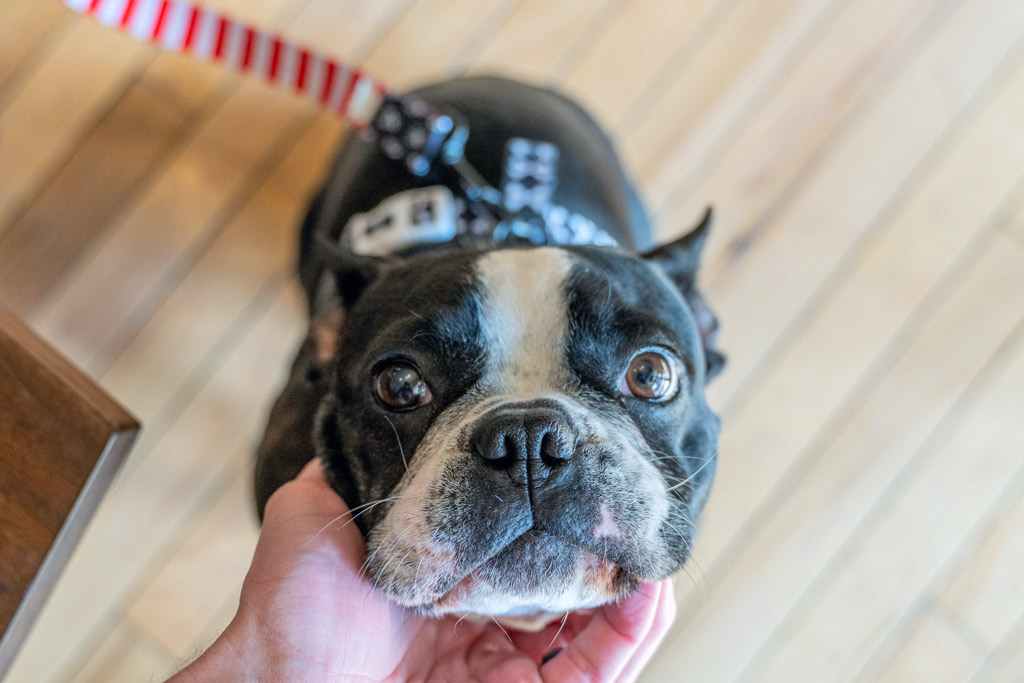
Starting early with training your Boston Terrier to walk by your side will prevent future pulling incidents. “But they’re not big dogs, so they wouldn’t have much pulling strength anyway, right?”.
Well, don’t let their small frame fool you; the reality is Boston Terriers are strong and can be real leash pullers! They might be called the American Gentleman, but there’s nothing gentle about their pulling if left unchecked.
You can train your Boston Terrier to walk on a leash without pulling in 8 steps:
- Start leash training indoors (to avoid distractions).
- Practice getting the harness on (to get your Boston comfortable and compliant with having a leash on).
- Walk your Boston Terrier on a leash at home (the initial practise).
- Repeat for your Boston Terrier to learn.
- Take your time before going for an outside walk (don’t feel like you need to rush the process).
- Keep the leash training sessions short and sweet.
- Establish a walking routine for consistency.
- Always end on a good note (reward your dog).
The older your Boston is, the greater the challenge in teaching him to walk nicely on a leash, but it’s not impossible.
Walking your pooch with confidence, calm, and without fear of losing an arm is a great feeling. Plus, you get to enjoy it as you look forward to those wonderful walks together!
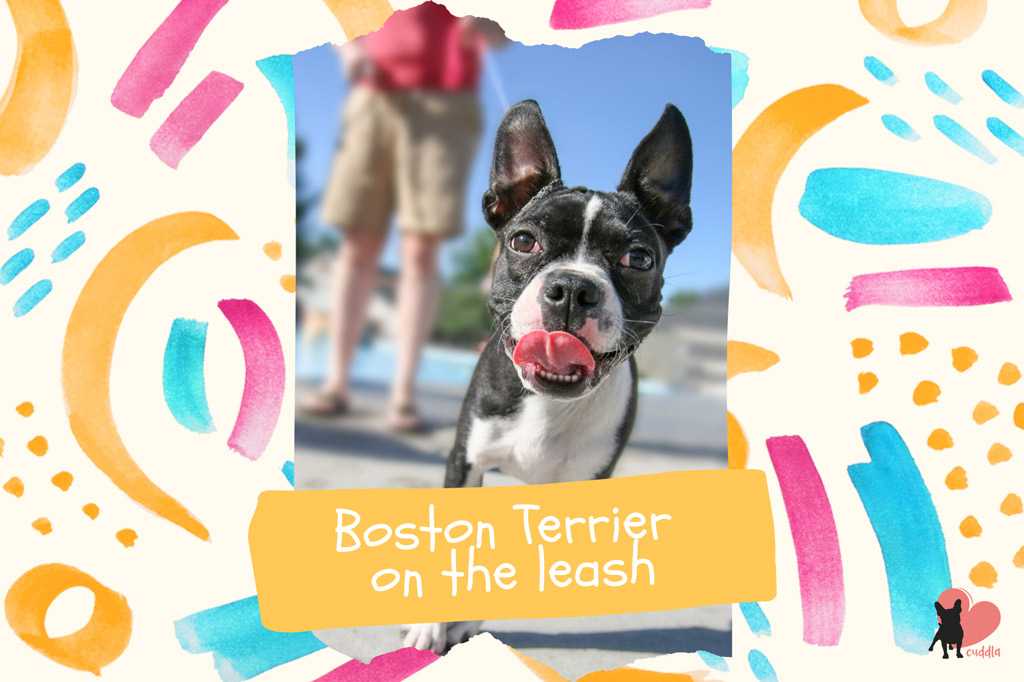
Boston Terrier Leash Training
As well as wanting stress-free walks with your pooch, many places have leash laws. Also, there will be times when you will want to keep your dog on a leash for his own safety.
So, here’s how to train your Boston Terrier to walk on a leash without pulling:
#1 – Start Leash Training Indoors
The first thing to do is to make sure that you start off in a calm and controlled environment.
You can start practising indoors (at home), where there are fewer distractions, like in the hallway. Then, you can take it to the garden if you have one.
A non-distracted dog is more responsive and you will have better control and communication with him especially when you are in a known and secure environment.
The main focus here is obedience and responsiveness. Here are some things you can practise:
- Stop signal: You want your BT to stop when you stop walking and also if you give the command.
- Change of direction: If you turn around or go in a different direction, your pooch should follow your lead.
- Wait: When your doggy gets ahead of you, he should stop at some point and wait for you to catch up. This might be easier with a retractable lead.
- Return: Same as waiting, your doggy should also ideally return back to where you are, especially if you stop and stand in a spot. Also easier with an extendable or long lead.
- Eye contact: Looking up or back at you from time to time.
Once you are happy with your Boston’s progress, raise the challenge and take him for a walk in the street.
I recommend leaving parks as a final step of the leash training, since there are many distractions, including other dogs that are off-leash.
Insider Tip: Keep in mind that this is a progressive training approach, so how your dog behaves indoors is not exactly how he’ll behave outdoors – it’s a foundational step. This will save you the frustration if and when your BT seems like he’s forgotten everything you’ve built up so far.
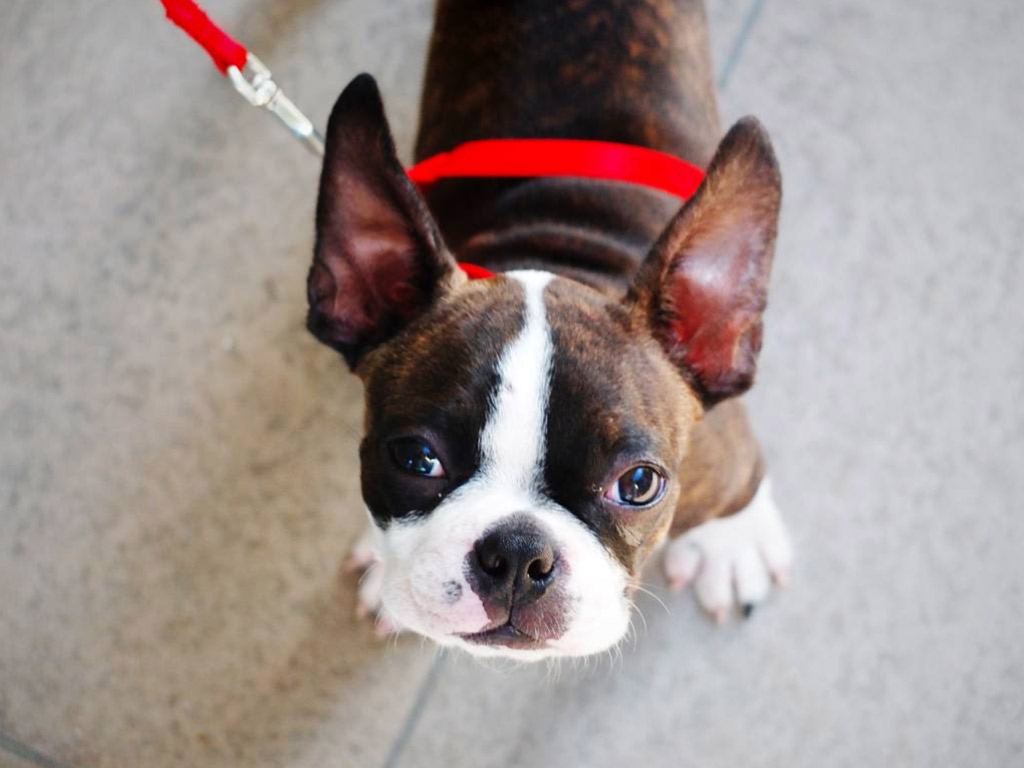
#2 – Practice Getting the Harness On
Note: If you are just getting started, you may want to scroll down to the bottom to know what you need for leash training your Boston Terrier.
Getting the harness on can be another training session of its own, so take it easy and don’t rush! After getting comfortable with putting the harness on, attach the leash to your Boston Terrier’s harness. You can either attach it to the front or the back ring of the harness.
Let your Boston sniff the gear and reward his progress.
In the beginning, it can be hard to get the harness on if your pooch is reluctant. So, try to make this experience as positive as possible. In the end, you want to be able to put the gear on and exit the house without any fuss.
#3 – Walk Your Boston Terrier On Leash
Here are a few pointers to go through the motion. You’ll need a leash, harness (or collar) and some bite-sized, tasty treats, perhaps in a treat bag that fits around your waist:
- Choose which side you would like your dog to walk on and then stick to it. Left alone, your pooch will dance circles around you so this helps keep consistency and establish a “zone”.
- Hold the lead in one hand and a treat in the other. Keep the lead loose (if it is too tight, your dog will pull on it) and hold the treat by your side at your dog’s nose height.
- Show your dog the treat and walk forwards, praising and rewarding him when he’s beside your leg.
- As he follows your hand, say “heel” and give him the small treat.
- Keep some treats in your hand and keep going.
- Practice heel work on-leash walks. As she keeps to your side, say “heel” and give her another treat. Don’t stop walking.
- If your Boston doesn’t keep up with you or pulls in a different direction, suddenly change direction and encourage her to come with you. Praise her when she catches up and give her another treat.
Congratulations! You’ve just learned the basics of how to teach your dog to heel.
“Heel” is a well-known training cue/command that can help you keep your pooch under control, especially when there are a lot of distractions when you’re walking. It’s also something most trainers use in canine competitions as a training aide in canine competitions e.g. Rally Obedience.
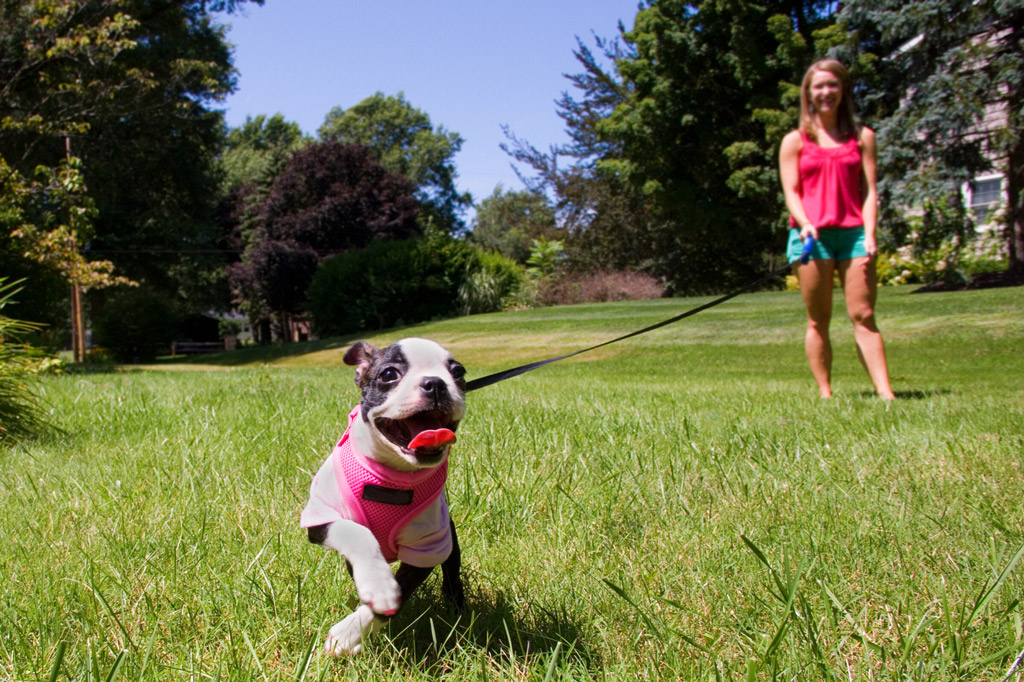
#4 – Repeat for Your Boston Terrier to Learn
Dogs learn with constant repetition.
So, practice walking your dog daily. Go through the motions in step #3 and keep rewarding your Boston Terrier with praises, cuddles and treats!
#5 – Don’t Rush the Process
Remember to take baby steps when training your Boston Terrier. Only move to the next challenge once he follows your command.
Then, you can add more distractions, distance, and time to your training sessions. You can take the walks from the hallway to the garden, then to the driveway and the street, and finally to the park.
Also, you can alternate the treats to keep the rewards interesting and motivating for your pup! If your pooch is less excited about a treat, it’s time to switch it up.
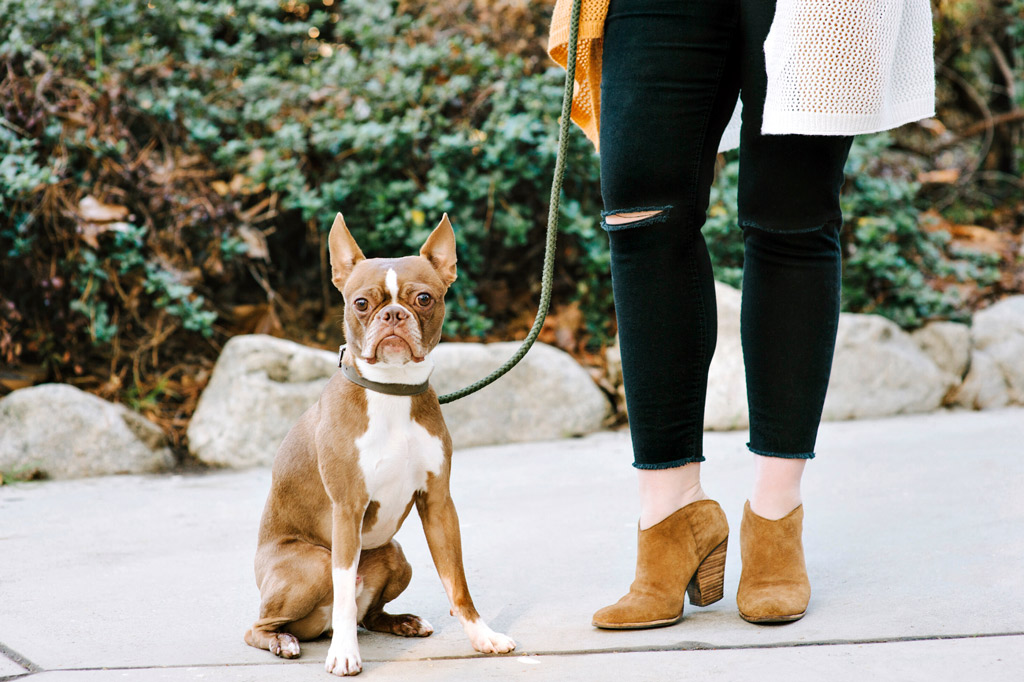
#6 – Keep the Leash Training Sessions Short and Sweet
It’s easier to start with short training sessions of 5 minutes first because your pup has a short attention span. You don’t want your Boston to get bored; the goal is to keep him wanting more!
Later on, you can build up to 10-minute long sessions, and progress to full walks in the end.
Depending on your Boston Terrier’s age, your dog can tolerate a certain amount of exercise:
- Boston Terrier puppies: 5 minutes of exercise per month of age (up to twice a day) until your puppy is full-grown. This means 15 minutes of exercise up to twice a day when your pup is three months old, for example.
- An adult Boston Terrier: Minimum requirement of 1-hour daily exercise, although some are happy to go longer!
- A senior Boston Terrier: Lower intensity exercise for a total of 30 – 45 minutes a day. This can be broken down to smaller time slots.
Read also: How Much Exercise Do Boston Terriers Need?
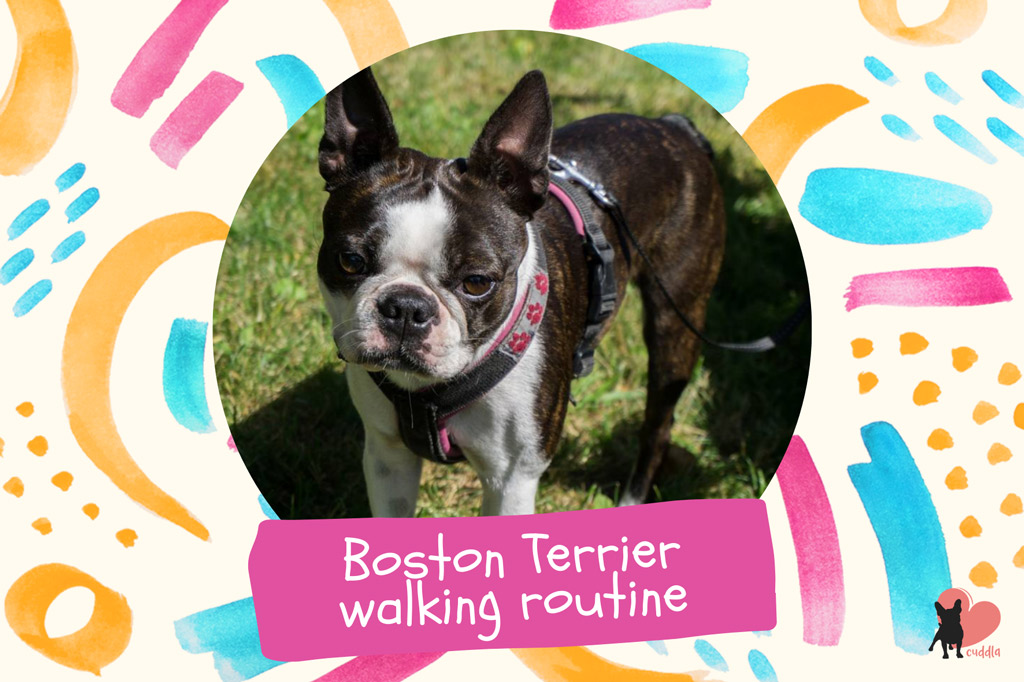
#7 – Establish a Walking Routine
Adjust the practice according to how your dog responds. Continue with the treats if he needs more encouragement. Otherwise, reduce the amount if he’s happy and obedient during walks.
Redirect your pooch as many times as necessary if he starts pulling again.
By the end of this training, you will enjoy a peaceful and fun walk with your Boston pup! Plus, your Boston will be happy to walk by your side!
Remember that the goal is to stay consistent with your direction and commands during the leash training sessions. You want to give your pooch clear signs using a positive toned voice. Also, you want to establish a daily walking routine and schedule.
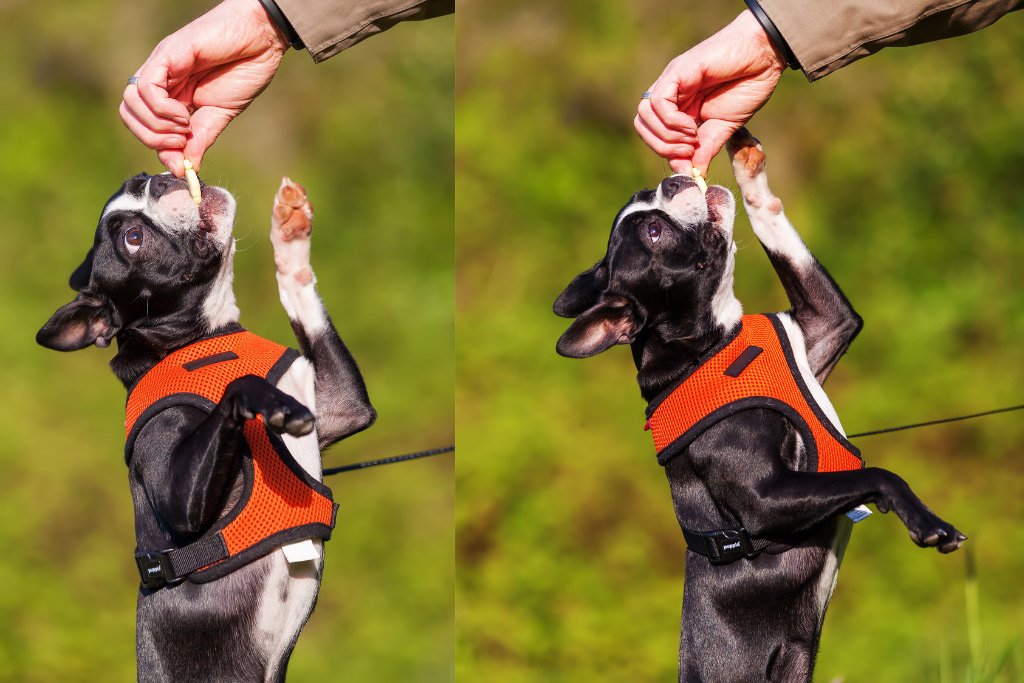
#8 – Always End on a Good Note
Always finish each training session on a good note. That’s easier said than done; I know that from personal experience.
Getting frustrated during sessions is very common. I’ve sadly lost my cool a number of times during leash training. Some dogs can be really stubborn and you need to stay calm and repeat, repeat and repeat some more until eventually, you see some progress.
Do your best to be patient and understand your dog’s learning rhythm. If you feel things are not working, take a rest and try again later when you feel more refreshed.
However, always show your love and praise your puppy at the end of the session. Dogs are very sensitive and can detect how you are feeling, so it’s best to not hold on to the anger or frustration!
P.S. Check Boston Terrier Training Method, Session and Schedule and Boston Terrier House-Training blog posts for basic training tips.
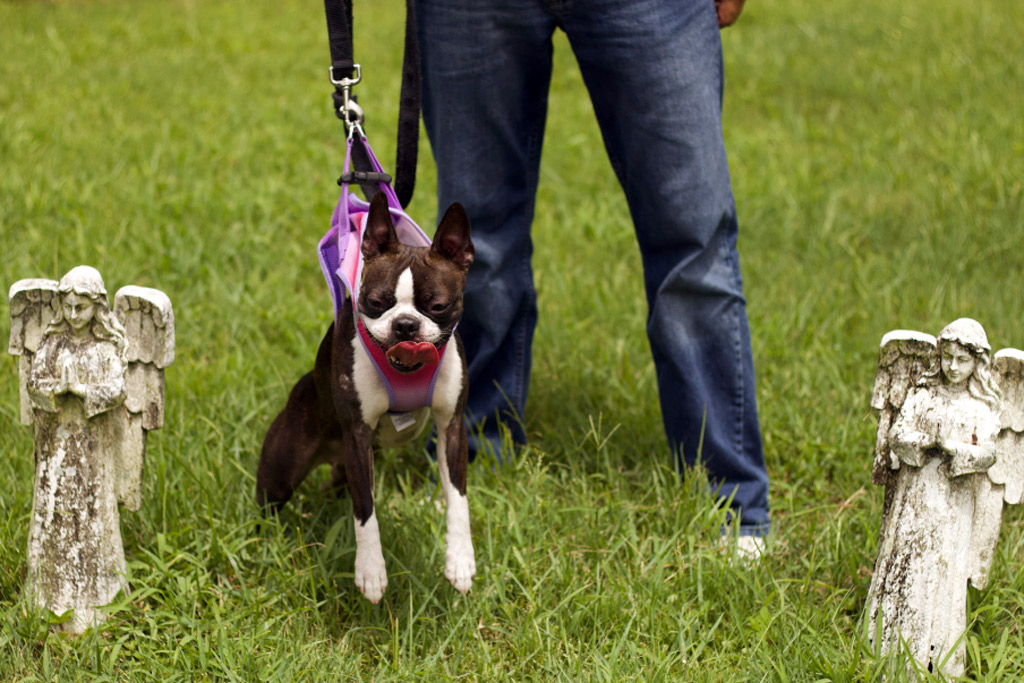
If Your Boston Terrier Pulls on The Leash
Pulling and tugging on the leash is a common behavioural problem that dogs have starting from their puppy days.
Most dogs that pull have learned to do so over a period of time. The longer they have been doing it, the harder it will be for them to change.
In most cases, they pull on the leash for three reasons:
- Anticipation.
- Control.
- Fear.
When you encounter unwanted behaviour such as pulling on the leash in your dog, always go back to the basics.
What I mean by that is to go back to the point where your dog follows your command well. For example, if your dog is pulling on the leash, you can stop, wait for him to look at you and then ask him to sit. Immediately rewarding him after he does it.
By doing so, you are interrupting the pulling with a positive action that your dog already knows how to do. This can end your frustration and encourage your dog to focus his attention on you, rather than what got him distracted in the first place.
Avoid yanking or pulling back on the leash if your pooch is pulling. If you pull with force, you can distress and hurt your dog.
While walking with your dog, the leash should remain loose. If your Boston pulls ahead of you, change directions so that he will end up behind you. You can add a trigger word like “let’s go.”
Insider Tip: Stop occasionally and gently lift up on the lead as you say, “sit.” This breaks up the pattern of being pulled. Doing so also creates eye contact and makes it fun.
Apart from treats, you can also bring a toy that your dog likes to keep his focus on you during walks. This encourages your dog to stay by your side.
Just don’t take a toy that he absolutely loves, because it will cause him to get overly excited, making it difficult to focus on you.
During walks, the key is to find the balance between letting your dog explore and you being his main focus of attention.
It is a natural, enjoyable behaviour for a dog to want to find out what is happening in her local area by sniffing the ground, lamp posts and fences for scents left by other dogs.
That’s why on walks you should allow your Boston Terrier to have a sniff around. This is a natural behaviour for dogs, not an unwanted behaviour. So allow your pooch to explore and let him get mentally stimulated during the walk.
However, you can choose and direct your pup on when to explore. When you are ready to let him do this, use a command such as “off you go.”
Your dog will associate the command to being allowed to explore at that particular moment. For instance, you could allow him this freedom as a reward after he’s been walking by your side without pulling for a while.
Finally, be patient, since a dog’s natural walking pace is usually twice as fast as the average human’s. Your Boston Terrier has to make a big adjustment to follow your command.
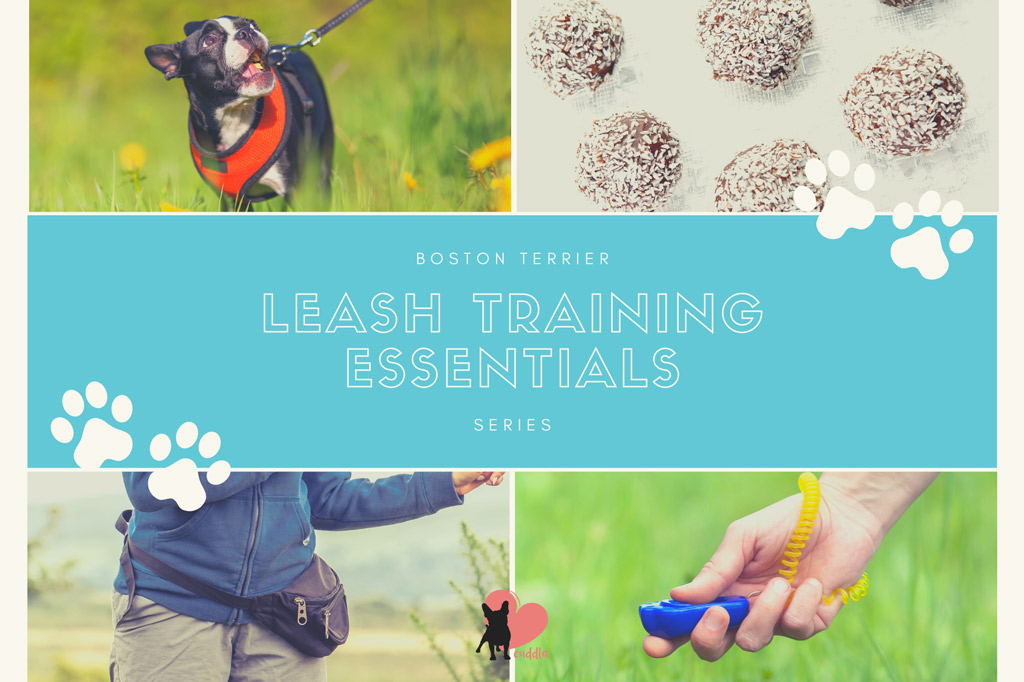
Leash Training Essentials
There are some props that will help you and your Boston Terrier when you begin leash training your pooch. Here’s what I use:
Dog Harness
Your pooch will walk better on a lead (i.e. without pulling) if he’s wearing a dog harness. Also, it gives you better control of your dog when walking him thanks to the back and front attachment points.
Plus, because Boston Terriers are a brachycephalic breed, harnesses don’t disrupt their breathing compared to collars.
Dog Leash
A short fixed-length dog leash is ideal to train your dog to walk by your side. These are 4 or 6-foot long.
Dog Clicker
A dog clicker is a sound-emitting device that aims to signal to your dog that he has done the right thing.
This tool is optional. However, if you are using a clicker for other training, implement it during leash training too! Remember that consistency is key!
Dog Treats
Small high-value treats are a great way to reward your dog during leash training.
- Small treats because: Easy to digest during walks.
- High-value treats because: They are a motivating enough reward for your Boston to follow your command.
Just don’t overfeed him!
Your pooch’s food rewards should be included in his daily food intake ration. Use the High-Value Dog Treats guide for ideas and my favourite dog treats for healthy alternatives.
Treat Pouch
A treat pouch is convenient to keep treats at hand every time you are training, including your daily walks. Also, you keep your pockets clean!
Plus, you can carry poop bags and a clicker inside. I tend to put my phone and house keys there too since sometimes my clothes don’t have large enough pockets or no pockets!
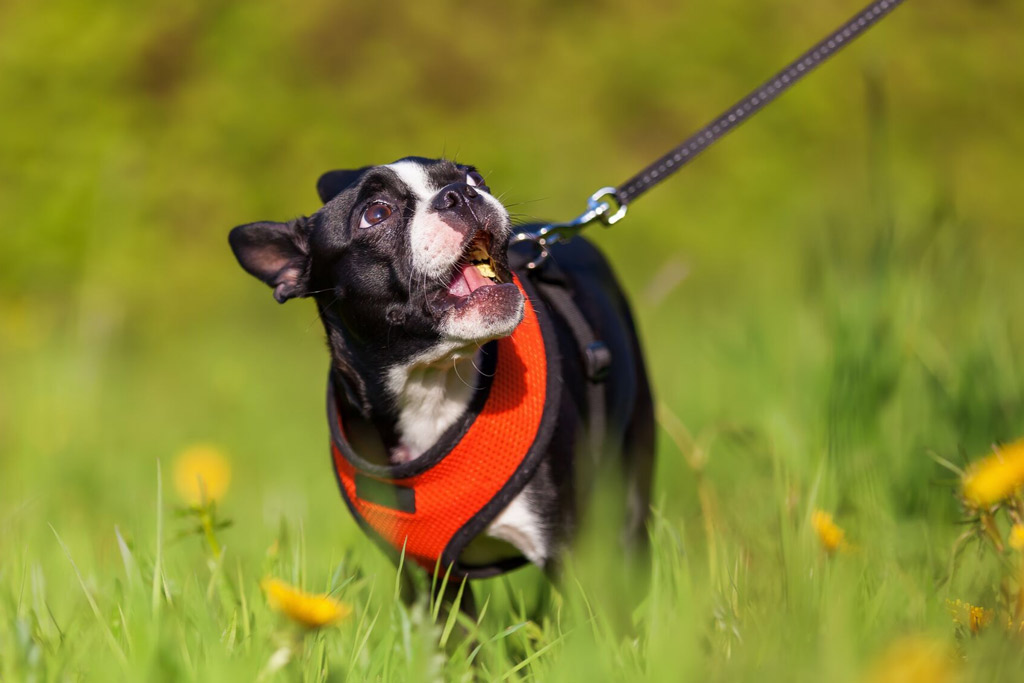
What’s Next
As well as leash pulling training, if you’re just getting started with training your Boston Terrier, you probably are facing the 2 other most common challenges:
- Potty training.
- Biting/nipping.
If so, I may be able to help with that. Click here to visit our Dog Training Essentials, where you will get a 3-part mini audio series + the everyday resource used by a well-known dog trainer.
You can also get this using the button below. Happy training! 😉

